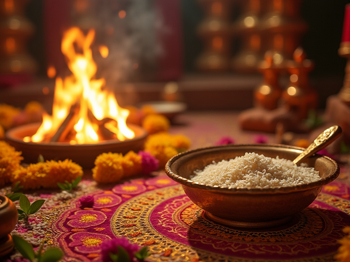The Annaprashan Puja holds great importance in Hindu tradition as it signifies a child's first intake of solid food. Typically performed when the child is between six months to one year old, this ceremony is more than just a feeding ritual. It represents the parents' prayer for their child's health, longevity, and prosperity.
The ritual involves offering the first grains to the child, symbolizing nourishment and the beginning of a healthy life. It is a way to seek blessings from the divine and ancestors for the child's well-being and development.
Annaprashan Puja is often celebrated with family and friends, marking a joyous occasion filled with love, laughter, and blessings for the child's future.
Annaprashan Puja is believed to confer numerous benefits on the child:
- Health and Well-being: The ritual is said to ensure the child's good health and well-being as they transition to solid foods.
- Divine Blessings: Invokes blessings from deities and ancestors, seeking their protection and guidance for the child's growth.
- Positive Energy: Fills the home with positive energy and auspicious vibrations, fostering a nurturing environment.
- Family Unity: Strengthens familial bonds as relatives come together to bless and celebrate the child's milestone.
- Cultural Continuity: Connects the child to their cultural and religious heritage, fostering a sense of belonging and tradition.
Select an Auspicious Date
- Consult a Priest or Astrologer: It's important to choose an auspicious date and time (muhurat) for the ceremony based on the child’s horoscope.
2. Prepare the Puja Area
- Clean the Area: The place where the puja is to be performed should be thoroughly cleaned.
- Set Up the Altar: Place an idol or picture of Lord Vishnu or the family deity on the altar, decorated with flowers, incense, and a lamp.
3. Gather Puja Materials
- Rice and Ghee: For the first meal.
- Panchamrit: A mixture of milk, yogurt, honey, ghee, and sugar.
- Fruits: Such as bananas, apples, or any other seasonal fruit.
- Puja Thali: Including roli (kumkum), rice, flowers, incense sticks, diya (lamp), and sandalwood paste.
- Betel Leaves and Betel Nut
- Tulsi Leaves: If available, as they are considered auspicious.
- New Clothes: For the baby, typically in yellow, red, or white.
- Gifts: Like gold or silver items, for the baby.
- Holy Water (Ganga Jal): For sprinkling and purification.
4. Bathing and Dressing the Child
- Purification: Bathe the child, ideally using a few drops of holy water in the bath.
- Dress the Child: In new, preferably traditional, clothes.
5. Invoking the Deities
- Lighting the Lamp: Light the lamp and incense sticks on the altar.
- Sankalpa (Intention): The priest or the head of the family should state the purpose of the ceremony, including the child’s name, parents’ names, and the intention to perform Annaprashan.
- Chanting Mantras: The priest will chant mantras invoking Lord Vishnu and other deities, seeking their blessings for the child.
6. Feeding the Child
- Offerings: The priest first offers the food to the deity.
- First Feeding: The eldest male family member (typically the father or maternal uncle) feeds the child with a small amount of the first solid food, usually kheer (a sweet rice pudding).
- Mantras: While feeding, specific mantras are recited by the priest to bless the child with health, prosperity, and a good appetite.
7. Aarti and Blessings
- Aarti: Perform the aarti to the deities and then to the child, using a plate with a lit diya, kumkum, and flowers.
- Family Blessings: Family members take turns feeding the child a small bite of food and giving blessings, often accompanied by small gifts.
8. Distribution of Prasad
- Offering Prasad: Distribute the remaining food as prasad to all the guests, symbolizing the sharing of the blessings.
9. Conclusion
- Final Prayers: Offer final prayers, seeking the deity’s continued blessings for the child’s well-being.
- Thanking the Priest: Offer dakshina (monetary gift) to the priest as a token of appreciation.
10. Celebration
- Feast: After the ritual, a family feast is typically organized, where guests are served a variety of dishes, symbolizing the child’s entry into the phase of solid food.
This ritual not only marks an important milestone in the child’s life but also serves as a joyous family gathering where blessings are showered on the baby for a healthy and prosperous future.




